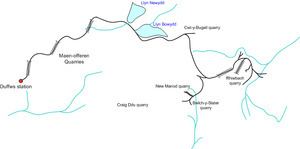Dates of operation 1861–1961 Length 4,828 m | Track gauge 1 ft 11 ⁄2 in (597 mm) Locale Wales | |
 | ||
Headquarters Blaenau Ffestiniog, United Kingdom | ||
The Rhiwbach Tramway was a Welsh industrial, 1 ft 11 1⁄2 in (597 mm) narrow gauge railway connecting the remote slate quarries east of the Blaenau Ffestiniog with the Ffestiniog Railway.
Contents
History
The first attempts to build a tramway to connect to quarries east of Blaenau Ffestiniog were made in 1854, when a petition to build the Ffestiniog and Macho Railway was presented to Parliament. This would 'authorise the construction of a new line of railway from Duffws to the Machno Slate Quarries and other purposes'. The intent was that this would be quite separate from the Ffestiniog Railway. The bill was promoted by Thomas Spooner, but was abandoned at the committee stage. One factor may have been the Ffestiniog Railway's insistence that all products produced by the quarries served should be exported via the railway, and this caused disagreement among the quarry owners. A second scheme was promoted in the late 1850s, to connect to the Rhiwbach Quarry, missing out the Penmachno Quarry. It was this scheme that was subsequently built.
The Ffestiniog Railway built an extension beyond Duffws in 1860, to connect to the end of the tramway, which they built in 1861, although it was financed by the Festiniog Slate Company Ltd, owners of the Rhiwbach Quarry. It was in use by two quarries in early 1862, but was not finally finished until early 1863. Quarries which used the tramway paid tolls to the Festiniog Slate Company.
The tramway remained in operation over its full length for close to a century. The section between Cwt y Bugail and Rhiwbach was lifted in 1956 and the section from Cwt y Bugail to Maenofferen was closed in 1961 and lifted in 1964. The first incline was replaced by a road, but a short section remained in use between the mills at Maenofferen and the foot of No 2 Incline, which became the last remaining gravity incline in the North Wales slate industry. This section was finally closed in 1976 after a new quarry road was built connecting the upper levels of Llechwedd with the mills at Maenofferen. Most of the track was lifted, although short sections of track remained intact as late as 2013.
Route
The quarries connected to the tramway had no practical road access as they lay at a high altitude in a remote moorland. Rhiwbach Quarry was about 1,560 ft (475 m) above sea level, while the main tramway was higher still, at around 1,625 ft (495 m). The tramway rose by three inclines through Maen Offeren quarry to reach the plateau. The first incline, Rhiwbach No. 1 (sometimes known as Bowydd incline or Dolgarregddu incline) climbed from a junction at the east end of the Ffestiniog Railway's Duffws station approximately 300 ft along the base of Garreg Ddu mountain. The line then skirted the western edge of Votty & Bowydd Quarry. Rhiwbach No. 2 incline then rose a further 350 ft to reach the level of the Maenofferen quarry mills. The tramway ran a quarter of a mile south to pass the Maenofferen mills and the foot of the last incline. Rhiwbach No. 3 incline climbed a further 300 ft to reach the plateau above Blaenau Ffestiniog, passing the main pit of the David and Jones Quarry.
From the head of No. 3 incline, the tramway ran on an approximately level course east towards Cwt y Bugail Quarry. It skirted the edge of Llyn Bowydd, a reservoir constructed to supply water to power the equipment in the quarries below. From Cwt y Bugail, the line turned south, passing Blaen y Cwm Quarry to the head of the incline down to the Rhiwbach quarry which lay below the plateau in the Machno valley. A further branch ran south from Blaen y Cwm, via a switchback, to Manod and Bwlch y Slaters quarries.
Operations
The tramway was originally designed to be worked by horses and gravity. During busy periods, 2 or 3 horses were required to work the summit section between the top of No. 3 incline and the Rhiwbach incline. Sometime in the 1920s petrol locomotives were introduced to work this section and a small shed was built in which the locomotive was kept. The practice was not entirely successful, as the locomotive was too heavy for the track materials used, and parts of the tramway were relaid in light section flat-bottomed rail or heavier section bridge rail. In 1953 the Rhiwbach Quarry closed, leaving the Cwt y Bugail Quarry as the only user of the main section of the tramway.
Locomotives
This table shows locomotives known to have worked the Rhiwbach Tramway.
